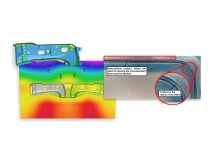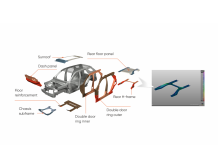Accounting for the 1000th Stroke in the ASPECT Project
 Right now TriboForm is undertaking an ambitious project that started in May 2016. Twelve European industrial and academic partners have joined. Their project is ambitious in that it aims to allow stamping processes to accelerate production ramp-up and continue the production run far longer than ever before. It is funded by the INTERREG North-West Europe Programme, from the European Regional Development Fund.
Right now TriboForm is undertaking an ambitious project that started in May 2016. Twelve European industrial and academic partners have joined. Their project is ambitious in that it aims to allow stamping processes to accelerate production ramp-up and continue the production run far longer than ever before. It is funded by the INTERREG North-West Europe Programme, from the European Regional Development Fund.
The target is to increase productivity in stamping for OEM’s by a whopping 40% and secondly to reduce maintenance cost of the whole production line by 20-25%. They will find out what friction, heat and tribological effects result in failed parts on stamping lines and create counter measures.
ASPECT also aims to present a new form of simulation considering the evolution of the tribo-system during a production run, modelling the heat and lubricant behavior after the hundredth and even the thousandth stroke.
Therefore the project aims to entirely revolutionize sheet metal simulation.
The Current Problem of Die Stamping:
After a certain number of parts the stamping process may start to fail and produce defective parts, with for instance cracks or wrinkles. Yet process conditions, such as stroke velocity, blank holder forces etc. are maintained as a constant throughout the whole stamping process. The project aims to define where this failure really comes from and what measures may be taken to work around those forces.
The main cause is the increase in temperature. The equipment such as tooling and die holders commence at room temperature but friction and plastic deformation takes place during production. Consider how this influences oil. Rising temperatures in the tools affect the process by changing e.g. the viscosity of the lubricant. The viscosity changes the friction conditions in the press, which further affects hardening and sheet formability.
Presses have adopted systems which control how much/where oil is sprayed over different spots, although friction conditions of the first stroke are far different to the 1,000th stroke. This is why still today some processes are not robust, producing scrap when tools are cold, resulting for example in the first 100 parts being thrown to scrap, and only upon reaching ideal temperatures are good parts produced. On the other hand production starts well and then later splits and wrinkles occur. Faced with demands such as keeping enough parts on stock for manufacturers vs. how many parts may be produced before rejects occur the project aims to introduce a new form of simulation.
What’s the Project Doing?
‘Within the project TriboForm is investigating tribology systems of different zinc coated steel grades, using adapted lubricants and are subsequently identifying the temperature dependent tribology properties’ says Daan Waanders. ‘This includes the temperature dependent properties of the sheet metal, the tooling as well as the lubricant which projects the whole tribology system, showing the reality of how parts behave as a result of different contact pressures, velocities and various lubricant amounts.’
In its second step the project will transfer these effects, as identified by several partners, into finite element codes, producing a model that can predict destructive frictions and temperatures.
‘Such a finite element code should be able effectively reproduce a simulation of not only one stroke, but of ten, a hundred and even one thousand. Consider that currently engineers settle for simulations that account for just the first stroke, without consideration repetitive strokes. During the first stroke energy arises from friction and plastic deformation, producing heat. But this new model aims to monitor heat increases and friction over its continued use over repeated strokes. This is where we’ll come up with new and original ideas. But this is the hard part. You cannot measure the influence of all 100 strokes in a row. That would be too time-consuming. Our software will show the result at certain intervals, 100 strokes, 1000 strokes and so on. Such a model will be based on how these effects evolve in the real world over time, as a gradual process. This model will be entirely new.’

The project aims to place this model into the hands of the end user. It will offer enhanced simulations by predicting and mimicking the temperature variations within the stamping machine and it will intelligently reveal how the heat within the machine is rising, varying and declining.
Once the prototype code has been developed other project partners will step in and practice controlling these processes.
Daan Waanders said ‘In looking at the finite element codes they’ll see where the temperature becomes critical according to the TriboForm model, and then they can predict what has to be done. There are several actions that may be taken such as increasing or decreasing the stamping velocity, changing the blank holder force or the feeding rate. Perhaps the machine itself needs time to cool down. There are so many things that may be adjusted here in order to compensate for these effects, allowing production to avoid failed products in future.’
The Future Solution of Die Stamping:
The third phase of the project will allow for engineers to start controlling the whole procedure. Both Phillips and Opel are going to provide demonstration lines in order to test and validate the results of the previous steps. In measuring temperatures during stamping they’ll determine how accurate the element code truly is and if it accurately predicted what transpired in production reality.
In the project they’ll further design and introduce new capabilities for metal alloys and lubricants. These new lubricants will be developed within the project in order to observe how well these new alloys and lubricants counter the effects which predictively cause failure.
Several factors can now be controlled as a countermeasure to these tribological effects, including the stroke rate, blank force holder rate and the time instance between each stroke. Here the feeding rate may be increased or decreased as an option but the oil would not be changed.
Long term the project sees more specialization in the industry, as the gain of knowledge and knowledge transfer will result in highly skilled jobs. Users and engineers will become more skilled in this specific topic and triblogy will provide the competitive edge over other production lines once the increase in production speed and turnout success has been realized.
We definitely look forwards to seeing the results of this project.
See our two previous TriboForm interviews here:
Part 1: The TriboForm Story that Brought Tribology Forward for Simulation Companies Stuck Using Fixed Friction Values.
Part 2: Tribology Enters Simulation – How TriboForm Transformed a Consulting Solution into a Commercial Software Product – Tips & Tricks.
And don’t forget, you can sign up to our blog to stay informed.













